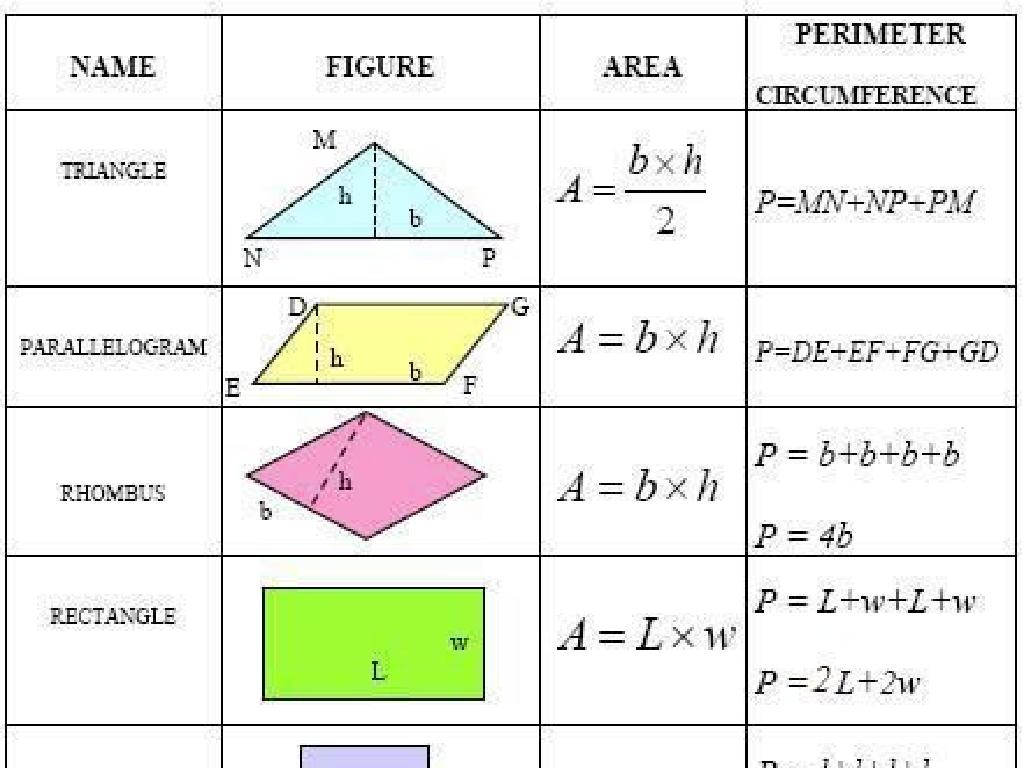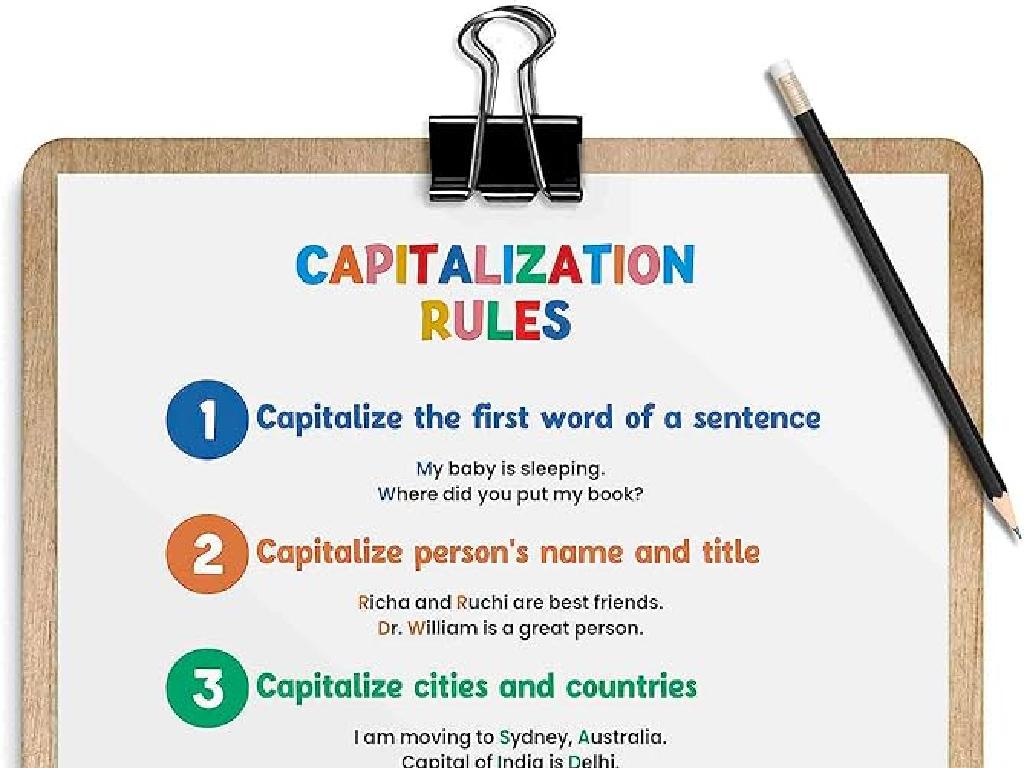Which Subtraction Sentence Is True? - Up To 18
Subject: Math
Grade: Second grade
Topic: Subtraction: One Digit
Summary: This engaging second-grade math lesson teaches students to identify and validate one-digit subtraction sentences with answers up to 18. Learners explore real-life subtraction examples, practice using objects and number lines, and participate in interactive classroom activities to distinguish true from false sentences. Through hands-on tasks and team exercises, students develop strong subtraction skills and accuracy, helping them confidently master essential math concepts.
Please LOG IN to download the presentation. Access is available to registered users only.
View More Content
Welcome to Subtraction!
– Learn about subtraction sentences
– Subtract numbers up to 18
– Take away numbers from a total up to 18
– Find true subtraction sentences
– Use subtraction facts to see which sentence is correct
– Practice with examples
– Example: Is 15 – 7 = 8 true or false?
|
Today’s lesson is focused on understanding subtraction sentences and practicing the skill of subtracting numbers up to 18. Begin by explaining what a subtraction sentence is: a mathematical expression that shows how much one number is reduced by taking away another. Emphasize the importance of being able to find the truth in these sentences, as it’s a fundamental math skill. Provide several examples on the board and work through them as a class. Encourage students to use their fingers or counters if they need to visualize the subtraction. After explaining, give the students a set of subtraction sentences and ask them to determine which are true. This will help reinforce their understanding and give them practical experience with subtraction.
Understanding Subtraction
– Subtraction means taking away
– Imagine you have 10 apples and give away 3, now you have 7.
– Numbers decrease when we subtract
– If you start with 18 balloons and 5 fly away, you’re left with 13.
– It’s like eating some of your cookies
– Say you have 8 candies and you eat 2, you will then have 6 candies.
– Fewer cookies left after eating
– For example, 12 marbles minus 4 marbles leaves you with 8 marbles.
|
This slide introduces the concept of subtraction to second graders by relating it to real-life situations, such as eating cookies, which they can easily understand. Explain that subtraction is simply the process of taking some away from a larger group, which results in having fewer items than you started with. Use tangible examples like cookies, apples, or candies to illustrate this point. Encourage students to think of their own examples of subtraction from their daily lives. This will help them grasp the concept of subtraction as it applies to numbers up to 18.
Understanding Subtraction Sentences
– Components of a subtraction sentence
– A subtraction sentence includes numbers, a minus sign (-), and an equals sign (=).
– Example: 5 – 3 = 2
– This is a simple subtraction sentence. We start with 5, subtract 3, and are left with 2.
– ‘Start with’ number explained
– The first number (5) is what we begin with before subtracting.
– ‘Take away’ and ‘Have left’ numbers
– We subtract the second number (3) and the result (2) is what remains.
|
This slide introduces students to the concept of subtraction sentences. It’s important to emphasize the structure of a subtraction sentence, which includes the numbers involved, a minus sign to indicate subtraction, and an equals sign to show the result. Use the example 5 – 3 = 2 to illustrate the concept, explaining that we start with the first number, subtract the second number, and the result is what we have left. Encourage students to think of subtraction as ‘taking away’ from what we start with. You can use real-life examples like removing apples from a basket to make this concept more tangible for second graders.
True or False: Subtraction Sentences
– Subtraction sentences can be false
– Always check if the answer fits
– Does 15 – 7 really equal 8? Let’s check!
– Learn to verify subtraction truths
– We’ll use objects and number lines to see if our subtraction is correct
– Practice with examples up to 18
– Try 12 – 5 or 16 – 9 and see if they are true
|
This slide introduces the concept that not all written subtraction sentences may be correct, and students must learn to verify them. Emphasize the importance of checking the answers to ensure they make sense. Teach students how to confirm the truth of a subtraction sentence using visual aids like objects to count or a number line. Provide several examples and encourage students to practice with numbers up to 18. This will help them build confidence in their ability to assess and validate subtraction sentences independently.
Checking Subtraction Sentences with Objects
– Use objects to check subtraction
– Blocks or fingers can represent numbers
– Match objects with subtraction answer
– If objects left match the answer, it’s correct
– Verify subtraction with an example
– Example: 10 – 3. Take 3 blocks away from 10
– Practice makes perfect
|
This slide is aimed at helping second-grade students understand the concept of verifying subtraction sentences using tangible objects like blocks or fingers. By physically removing the number of objects that corresponds to the number being subtracted, students can visually confirm if the subtraction sentence is true. For instance, if they have 10 blocks and they remove 3, they should have 7 blocks left, which corresponds to the subtraction sentence 10 – 3 = 7. Encourage students to use this method to check their work. During class, walk through several examples together and then let students practice this technique independently or in small groups with different subtraction problems.
Example Time: True Subtraction Sentences
– Is 7 – 4 = 3 true?
– Count 7 objects, remove 4
– Start with 7 items like pencils or blocks
– How many are left?
– After taking 4 away, count the remaining
– Verify the subtraction sentence
– Confirm that 3 items remain, proving the sentence true
|
This slide is aimed at helping second-grade students understand the concept of subtraction by verifying the truth of a subtraction sentence. Start by posing the question of whether 7 minus 4 equals 3. Then, guide the students through a hands-on activity where they physically count out 7 objects, remove 4, and then count how many are left. This visual and tactile approach helps solidify the concept of subtraction as ‘taking away.’ After the activity, discuss with the class why the subtraction sentence is true, reinforcing the idea that subtraction tells us how many things remain after some are taken away. Encourage students to try similar exercises with different numbers to practice.
Your Turn to Practice: True Subtraction Sentences
– Find true subtraction sentences
– Count carefully to check
– Take your time to subtract numbers up to 18
– Work with a partner
– Use objects for help
– Use counters, blocks, or fingers to subtract
|
This slide is designed to engage students in a hands-on activity to reinforce their understanding of subtraction. Students should work in pairs to encourage collaboration and discussion, which can lead to a deeper understanding of the concept. Provide them with manipulatives such as counters or blocks to visualize the subtraction process. Encourage them to double-check their work by counting carefully. As they work through the problems, remind them to identify whether each subtraction sentence is true. For example, they can check if 15 – 7 = 8 by counting backwards from 15 or by removing 7 objects from a group of 15. The goal is for students to become comfortable with subtraction and to understand the importance of accuracy in math.
Class Activity: Subtraction Hunt
– Explore the classroom for subtraction sentences
– Determine if each sentence is true or false
– Use mental math to verify subtraction results
– Record your answers on the worksheet
– Each sentence will be up to 18 – one digit numbers
– Share findings with the class
|
This interactive activity is designed to help second graders practice their subtraction skills in a fun and engaging way. Scatter subtraction sentences around the classroom, ensuring they are within the students’ reach and visible. Provide worksheets for students to record their answers. Encourage them to use mental math to determine if the subtraction sentences are true or false. After the hunt, gather the class and discuss the answers, reinforcing the concept of subtraction up to 18. Possible variations of the activity could include pairing students for collaborative learning, timing the hunt for a playful competitive edge, or offering small rewards for correct answers to motivate participation.
Becoming Subtraction Stars!
– Congratulations on your hard work!
– Subtraction shows how numbers decrease
– If you have 5 apples and eat 2, you have 3 left.
– Practice makes perfect in subtraction
– Try subtracting with toys, candies, or drawings!
– Keep it up and shine as subtraction stars!
|
This slide is meant to wrap up the lesson on subtraction by celebrating the students’ effort and understanding. Emphasize the practicality of subtraction in everyday life, such as when dealing with objects or when shopping. Encourage the students to continue practicing with different items to become more comfortable with the concept. Remind them that subtraction is not just about taking away but understanding the relationship between numbers. Celebrate their progress and motivate them to keep practicing to become ‘subtraction stars’ in their math journey.





